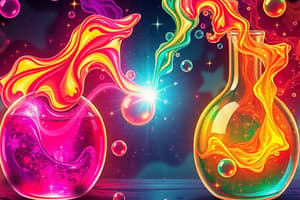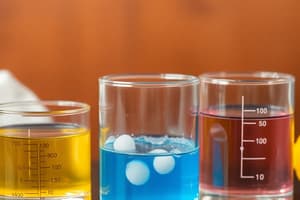Podcast
Questions and Answers
Which acid is commonly used in aerated drinks?
Which acid is commonly used in aerated drinks?
- Carbonic acid (correct)
- Citric acid
- Acetic acid
- Sulphuric acid
What is the primary use of nitric acid?
What is the primary use of nitric acid?
- Wine manufacturing
- Digestion
- Aspirin production
- Fertilizers (correct)
What type of solution contains less solute than a saturated solution?
What type of solution contains less solute than a saturated solution?
- Concentrated solution
- Dilute solution
- Unsaturated solution (correct)
- Supersaturated solution
Which acid is used in the human digestive system?
Which acid is used in the human digestive system?
Which acid is primarily responsible for creating the bitterness in aspirin?
Which acid is primarily responsible for creating the bitterness in aspirin?
What is a characteristic of a supersaturated solution?
What is a characteristic of a supersaturated solution?
What is the main function of tartaric acid in manufacturing?
What is the main function of tartaric acid in manufacturing?
Which of the following is a safe handling procedure for chemicals?
Which of the following is a safe handling procedure for chemicals?
Which of the following is NOT considered a colloid?
Which of the following is NOT considered a colloid?
What principle explains the ability of similar substances to dissolve each other?
What principle explains the ability of similar substances to dissolve each other?
Which combination of substances would be expected to dissolve efficiently in one another?
Which combination of substances would be expected to dissolve efficiently in one another?
What happens to ionic compounds when mixed with polar solvents like water?
What happens to ionic compounds when mixed with polar solvents like water?
According to the properties of solutions, how does stirring affect the dissolution process?
According to the properties of solutions, how does stirring affect the dissolution process?
In terms of particle size, what can be said about its influence on dissolution?
In terms of particle size, what can be said about its influence on dissolution?
What is the result of mixing a nonpolar solute with a polar solvent?
What is the result of mixing a nonpolar solute with a polar solvent?
Which of the following examples correctly illustrates a polar solute dissolving in a polar solvent?
Which of the following examples correctly illustrates a polar solute dissolving in a polar solvent?
What does the concentration of a solution refer to?
What does the concentration of a solution refer to?
Which of the following is NOT a common way to express concentration?
Which of the following is NOT a common way to express concentration?
In the example of nichrome wire, what does the 75% represent?
In the example of nichrome wire, what does the 75% represent?
What is the appropriate use of percent by mass?
What is the appropriate use of percent by mass?
If a solution is described as 'percent by volume', what does this measurement specifically indicate?
If a solution is described as 'percent by volume', what does this measurement specifically indicate?
What is the pH value range for acidic substances?
What is the pH value range for acidic substances?
Which option is used to neutralize a strong base like drain cleaner?
Which option is used to neutralize a strong base like drain cleaner?
Which of the following substances is NOT a common acid?
Which of the following substances is NOT a common acid?
What word does the term 'acid' derive from, and what does it mean?
What word does the term 'acid' derive from, and what does it mean?
What is the general property of bases in terms of pH?
What is the general property of bases in terms of pH?
What is produced when an acid reacts with a base?
What is produced when an acid reacts with a base?
Which of the following describes a neutral solution?
Which of the following describes a neutral solution?
What is an example of neutralization in everyday life?
What is an example of neutralization in everyday life?
Which statement correctly describes acids?
Which statement correctly describes acids?
What indicates the presence of a base when using litmus paper?
What indicates the presence of a base when using litmus paper?
What are the properties of a weak acid or weak base found in pure water?
What are the properties of a weak acid or weak base found in pure water?
Which process can help in treating factory waste?
Which process can help in treating factory waste?
What does it mean if a solution has a pH less than 7?
What does it mean if a solution has a pH less than 7?
What happens to the solubility of gases in liquids when temperature increases?
What happens to the solubility of gases in liquids when temperature increases?
What is the effect of temperature on the solubility of solid solutes in liquid solvents?
What is the effect of temperature on the solubility of solid solutes in liquid solvents?
According to Henry's Law, how does pressure affect the solubility of a gas in a liquid?
According to Henry's Law, how does pressure affect the solubility of a gas in a liquid?
Why do gas molecules dissolve more in liquids under increased pressure?
Why do gas molecules dissolve more in liquids under increased pressure?
What occurs to gas solubility in a liquid as bubbles form when the liquid is heated?
What occurs to gas solubility in a liquid as bubbles form when the liquid is heated?
Which chemist established the principle that relates gas solubility to pressure?
Which chemist established the principle that relates gas solubility to pressure?
What is the relationship between the temperature of a solvent and the rate at which a solute dissolves?
What is the relationship between the temperature of a solvent and the rate at which a solute dissolves?
What happens to the solubility of sugar in water when the temperature is increased?
What happens to the solubility of sugar in water when the temperature is increased?
Flashcards
Acids
Acids
Solutions with a pH less than 7, tasting sour, turning blue litmus paper red and having a stinging or wet feel.
Bases
Bases
Solutions with a pH greater than 7, tasting bitter or soapy, turning red litmus paper blue and feeling slippery.
Neutralization
Neutralization
A chemical reaction where an acid reacts with a base, producing salt and water.
Salt
Salt
Signup and view all the flashcards
pH
pH
Signup and view all the flashcards
Neutral Solutions
Neutral Solutions
Signup and view all the flashcards
Solubility
Solubility
Signup and view all the flashcards
Concentration
Concentration
Signup and view all the flashcards
What are acids?
What are acids?
Signup and view all the flashcards
What are bases?
What are bases?
Signup and view all the flashcards
What is a neutral solution?
What is a neutral solution?
Signup and view all the flashcards
What is the pH scale?
What is the pH scale?
Signup and view all the flashcards
What is neutralization?
What is neutralization?
Signup and view all the flashcards
Saturated solution
Saturated solution
Signup and view all the flashcards
Unsaturated solution
Unsaturated solution
Signup and view all the flashcards
Supersaturated solution
Supersaturated solution
Signup and view all the flashcards
Solute
Solute
Signup and view all the flashcards
Solvent
Solvent
Signup and view all the flashcards
Dissolving
Dissolving
Signup and view all the flashcards
Suspension
Suspension
Signup and view all the flashcards
Colloid
Colloid
Signup and view all the flashcards
Like Dissolves Like
Like Dissolves Like
Signup and view all the flashcards
Rate of Stirring
Rate of Stirring
Signup and view all the flashcards
Particle Size
Particle Size
Signup and view all the flashcards
Particle Size and Solubility
Particle Size and Solubility
Signup and view all the flashcards
Temperature and Gas Solubility
Temperature and Gas Solubility
Signup and view all the flashcards
Temperature and Solid Solubility
Temperature and Solid Solubility
Signup and view all the flashcards
Pressure and Solubility
Pressure and Solubility
Signup and view all the flashcards
Henry's Law
Henry's Law
Signup and view all the flashcards
Henry's Law Application
Henry's Law Application
Signup and view all the flashcards
Summary of Solubility Factors
Summary of Solubility Factors
Signup and view all the flashcards
Concentration of a solution
Concentration of a solution
Signup and view all the flashcards
Percent by Volume
Percent by Volume
Signup and view all the flashcards
Percent by Mass and Volume
Percent by Mass and Volume
Signup and view all the flashcards
Percent by Mass
Percent by Mass
Signup and view all the flashcards
Study Notes
Acids, Bases, and Salts
- Acids have a pH less than 7
- Bases have a pH greater than 7
- Neutral solutions have a pH of 7
- Acids taste sour, bases taste bitter or soapy
- Acids sting or feel wet, bases feel slippery
- Acids react with some metals to produce hydrogen gas
- Acids and bases conduct electricity in solution
- Examples of acids include fruit juices, soda, and coffee
- Examples of bases include baking soda, ammonia, and soap
Neutralization
- Neutralization is a chemical reaction between an acid and a base
- During neutralization, water and a salt are produced
- Neutralization has several everyday uses, including treating insect stings and indigestion, and using toothpaste to prevent tooth decay
Solutions
- Saturated solution: Contains the maximum amount of solute that can dissolve at a given temperature
- Unsaturated solution: Contains less solute than a saturated solution
- Supersaturated solution: Contains more solute than a saturated solution
Factors Affecting Solubility
- Temperature:
- Increased temperature generally increases the solubility of most solid solutes
- Increased temperature generally decreases the solubility of gases
- Stirring: Faster stirring increases the rate of dissolving
- Particle size: Smaller particles dissolve faster
- Pressure: Pressure significantly affects the solubility of gases in liquids (Henry's Law). Increase pressure, increases solubility.
Types of Solutions
- Colloids: Mixtures where tiny particles of one substance are evenly distributed throughout another substance (Tyndall effect)
- Suspensions: Mixtures in which solid particles are dispersed throughout a liquid but will settle over time
Concentration of Solutions
- Percent by mass: The mass of solute divided by the total mass of the solution, multiplied by 100
- Percent by volume: The volume of solute divided by the total volume of the solution, multiplied by 100
Studying That Suits You
Use AI to generate personalized quizzes and flashcards to suit your learning preferences.




